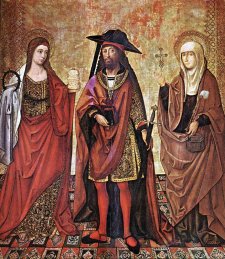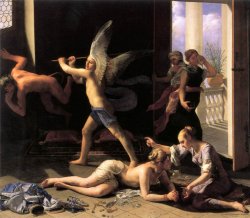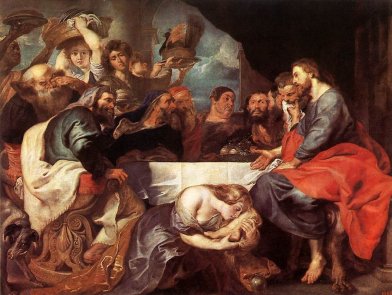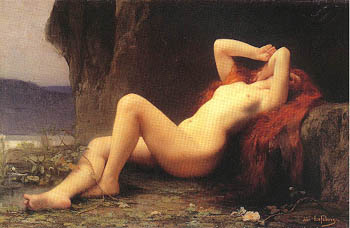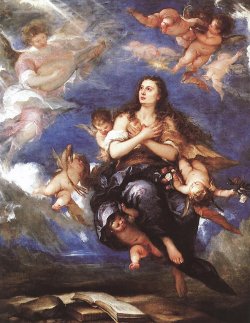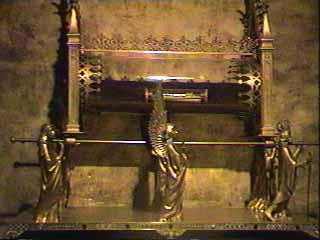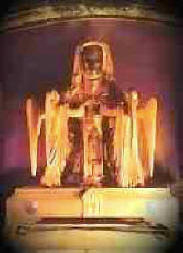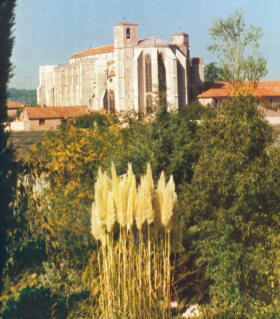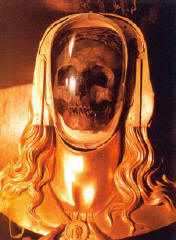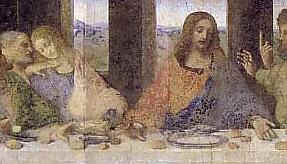The Life, History and Legends of Mary from Magdala
|
| Mary Magdalene was of the district of Magdala, on the shores of the Sea of Galilee, where stood her families castle, called Magdalon; she was the sister of Lazarus and of Martha, and they were the children of parents reputed noble, or, as some say, royal descendants of the House of David. On the death of their father, Syrus, they inherited vast riches and possessions in land, which were equally divided between them. Lazarus betook himself to the military life; Martha ruled her possessions with great discretion, and was a model of virtue and propriety, -perhaps a little too much addicted to worldly cares; Mary, on the contrary, abandoned herself to luxurious pleasures and became at length so notorious for her extravagant lifestyle that she was known through all the country round only as 'The Sinner'. |
| Her discreet sister, Martha, frequently rebuked her for these disorders and at length persuaded her to listen to the exhortations of Jesus, through which her heart was touched and converted. The seven demons which possessed her, and which were expelled by Jesus, were the seven deadly sins common to us all. The struggles of these seven principal faults are; first, Gluttony or the pleasures of the palate; secondly, Fornication; thirdly, Covetousness, which means Avarice, or, the love of money, fourthly, Anger; fifthly, Dejection; sixthly, "Accidie," which is the sin of spiritual sloth or sluggishness; and seventhly, kenodocila which means ego, foolish pride or vain glory. |
|
|
| | On one occasion Martha entertained the Saviour in her house, and, being anxious to feast him worthily, she was 'cumbered with much serving.' Mary, meanwhile, sat at the feet of Jesus, and heard his words, which completed the good work of her conversion; and when, some time afterwards, be supped in the house of Simon the Pharisee, she followed him thither and she brought an alabaster box of ointment and began to wash his feet with tears, and did wipe them with the hair of her head, and kissed his feet, and anointed them with ointment - and He said unto her, Thy sins are forgiven.' |
She became afterward one of the most devoted of his followers, always by his side and 'ministered to him of her substance' (provided the groups finances.) She attended him to Calvary, stood weeping at the foot of the cross and was the first to see the Christ risen. Extra-biblical and Gnostic traditions about Mary Magdalene holds that she was the wife of Jesus and pregnant with his child at the time of his death, a fact which was omitted by later revisionist editors of the Gospels.
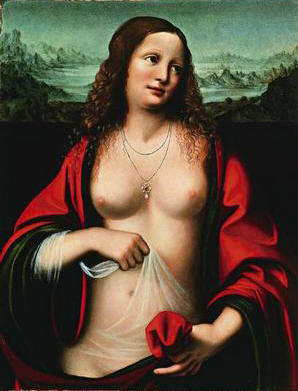 Mary Magdalen by Da Vinci. Note she is holding a thin "veil" over her reproductive area and pointing to her left ovary. | There is good argument which supports the idea of their marriage. Bachelorhood was very rare for Jewish males of Jesus' time, being generally regarded as a transgression of the first mitzvah (divine commandment): "Be fruitful and multiply". Mary Magdalene appears with great frequency (especially as compared with other women in the Gospels) and is shown as being a close follower of Jesus. In the scene of the wedding at Cana, the names of the nuptial couple are not mentioned, but Jesus acts as a groom would be expected to act at such a wedding. For example, by giving instructions to the servants (in fact, those servants were told by Mary his mother to obey his instructions). Finally, Mary's presence at the Crucifixion and Jesus' tomb is consonant with a role as grieving wife and widow. |
| After the Crucifixion she watched by his tomb, and was the first to whom he appeared after the resurrection; her unfaltering faith, mingled as it was with the intensest grief and love, obtained for her this peculiar mark of favour. It is assumed by several commentators that Jesus appeared first to Mary Magdalene, because she, of all those whom he had left on earth, was his beloved and in most need of consolation:-' The disciples went away unto their own; but Mary stayed without the sepulcher and wept.' |
|
Tradition relates that afterwards in Italy, Mary Magdalene visited the Emperor Tiberias (14-37 AD) and proclaimed to him about Christ's Resurrection. According to tradition, she took him an egg as a symbol of the Resurrection, a symbol of new life with the words: "Christ is Risen!" Then she told Tiberias that, in his Province of Judea, Jesus the Nazarene, a holy man, a maker of miracles, powerful before God and all mankind, was executed on the instigation of the Jewish High-Priests and the sentence affirmed by the procurator Pontius Pilate. Tiberias responded that no one could rise from the dead, anymore than the egg she held could turn red. Miraculously, the egg immediately began to turn red as testimony to her words. Then, and by her urging, Tiberias had Pilate removed from Jerusalem to Gaul, where he later suffered a horrible sickness and an agonizing death.
Suggestions of commentators and legend continues her story. Fourteen years after the ascension, Lazarus with his two sisters, Martha and Mary; with Maximin, one of the seventy-two disciples, from whom they had received baptism; Cedon, the blind man whom our Saviour had restored to sight; and Marcella, the handmaiden who attended on the two sisters, were by the Jews set adrift in a vessel without sails, oars, or rudder; but, guided by Providence, they were safely borne over the sea till they landed in a certain harbour which proved to be Marseilles, in the country now called France.
The people of the land were pagans, and refused to give the holy pilgrims food or shelter; so they were fain to take refuge under the porch of a temple and Mary Magdalene preached to the people, reproaching them for their senseless worship of idols; and though at first they would not listen, yet being after a time convinced by her eloquence, and by the miracles performed by her and by her sister, they were converted and baptized. And Lazarus became, after the death of the good Maximin, the first bishop of Marseilles.
|
|
| |
| Chapel in the Cave at St. Baume where Mary Magdalene is believed to have lived for 33 years as a hermit following the death of Jesus |
These things being accomplished, Mary Magdalene retired to the cliffs not far from the city. It was a frightful barren wilderness and in the midst of horrid rocks she lived in the caves of Sainte-Baume; there for thirty years she devoted herself to solitary penance for the sins of her past life, which she had never ceased to bewail bitterly. During this long seclusion, she was never seen or heard of, and it was supposed that she was dead.
Assumption of Mary Magdalene, by José AntolinezShe fasted so rigorously, that but for the occasional visits of the angels, and the comfort bestowed by celestial visions, she might have perished. She was given the Holy Eucharist by angels as her only food. Every day during the last years of her penance, the angels came down from heaven and carried her up in their arms into regions where she was ravished by the sounds of unearthly harmony, and beheld the glory and the joy prepared for the sinner that repenteth. One day a certain hermit, who dwelt in a cell on one of those wild mountains, having wandered farther than usual from his home, beheld this wondrous vision-the Magdalene in the arms of ascending angels, who were singing songs of triumph as they bore her upwards; and the hermit, when he had a little recovered from his amazement, returned to the city of Marseilles, and reported what he had seen.
Chapel on the cliff above the Caveat St. Baume where Mary Magdalene is believed to have been carried to heaven by angels.
According to Church tradition, Mary Magdalene remained in Rome until the arrival of the Apostle Paul, and for two more years still, following his departure from Rome after the first court judgment upon him. From Rome, Mary Magdalene, moved to Ephesus where she unceasingly laboured the holy Apostle John, who with her wrote the first 20 Chapters of his Gospel (John 1-9, John 10-20). There the saint finished her earthly life and was buried. Mary was transported miraculously, just before she died, to the chapel of St. Maximin, where she received the last sacraments. She died when she was 72.
In 899 the Emperor Leo VI translated her alleged relics to a monastery in Constantinople. It was not until the tenth century that devotion to Mary Magdalene, the composite saint, took root in the west.
| About 1050 the monks of Vézelay, an abbey recently reformed and affiliated to Cluny, began to claim her body, brought, they related, from the Holy Land either by a ninth-century saint, Badilo, or by envoys despatched by their founder. A little later a monk of Vézelay believed that he had detected in a crypt at St. Maximin in Provence, carved on an empty sacrophagus, a representation of the unction at Bethany. The monks of Vézelay pronounced it to be Mary Magdalene's tomb from which her relics had been translated to their abbey. Thus the erection of one of the finest examples of Romanesque architecture was made possible by pilgrims to a spurious relic. | |
|
| |
| |
The Mary Magdalene Reliquary (above left) is located in a crypt beneath the Basilica to Mary Magdalene in Saint Maximin de Provence, France (above center) where Mary Magdalene is purportedly buried. The reliquary contains what many believe is Mary Magdalene's skull (above right).
The Provençals, however, took full advantage of this development and outstripped Vézelay by pilgrimages to three places henceforward associated with Mary Magdalene. One of these was St. Maximin, where the crypt still contains sacrophagi attributed to the Magdalene, St. Maximin and St. Sidonius. The representation of the anointing has, however, disappeared.
Another is the Sainte Baume, a grotto in the face of a cliff, where Mary Magdalene is said to have spent long years in penance and ecstatic contemplation, whose detail was suggested by the life of the penitent Mary of Egypt.
The third is a church on the coast, built and fortified against pirates in the twelfth century. Dedicated originally to St. Mary (our Lady) of the Sea, its title became The Three Marys of the Sea--'Les Saintes Maries de la Mer." A legend originating about the year 1200 informs us that Mary Magdalene, driven out to sea by the Jews, landed there together with Mary, mother of James, Mary Salome, her sister Martha, their maid Sara, Lazarus, Maximin, one of the seventy-two disciples, and Sidonius, the man born blind. In fact Maximin and Sidonius were saints of Auvergne, the latter being the fifth century man of letters and bishop; Lazarus was a fifth century bishop of Aix; Martha, the two Martyrs and Sara were Persian martyrs of the fourth century whose relics were brought later to southern Gaul.
|
|
|
